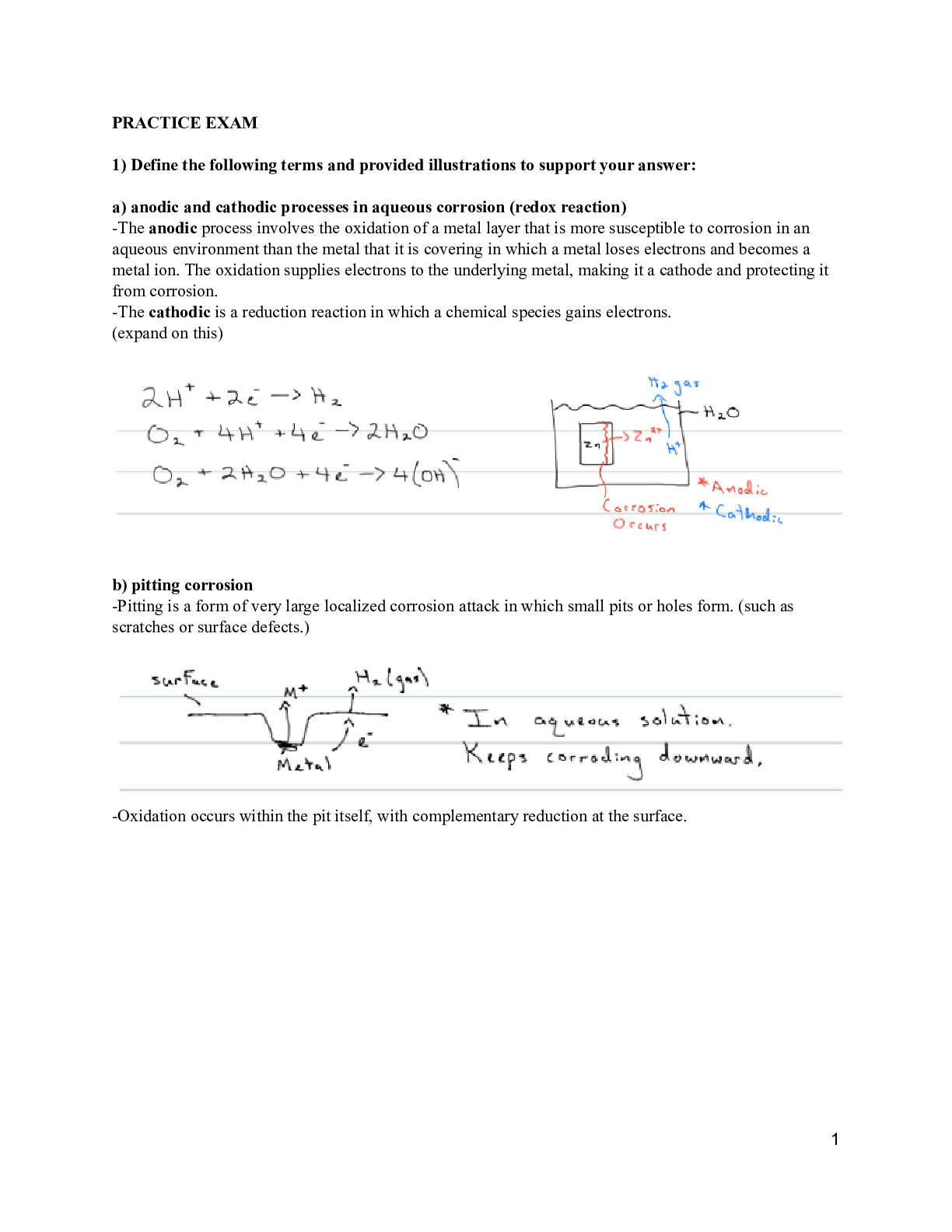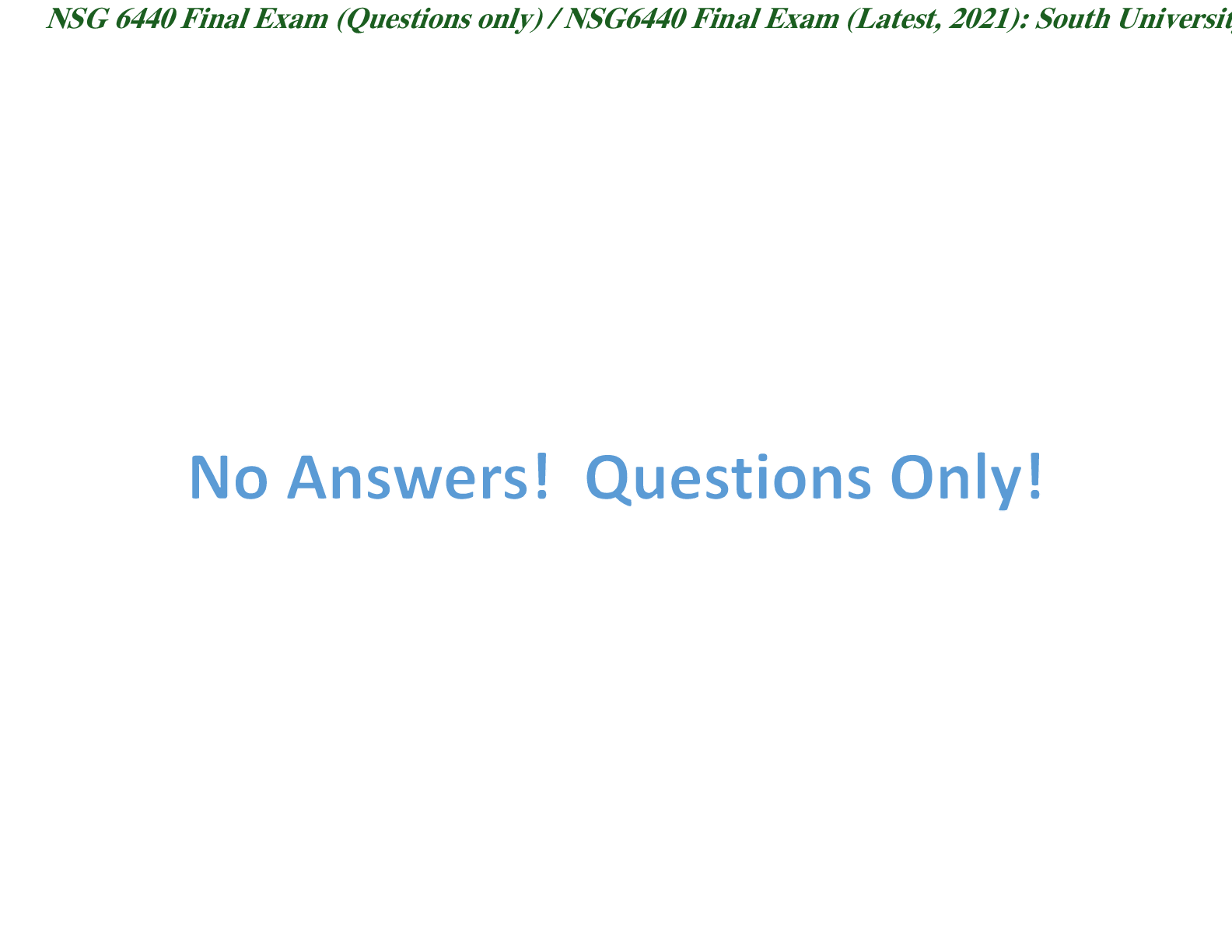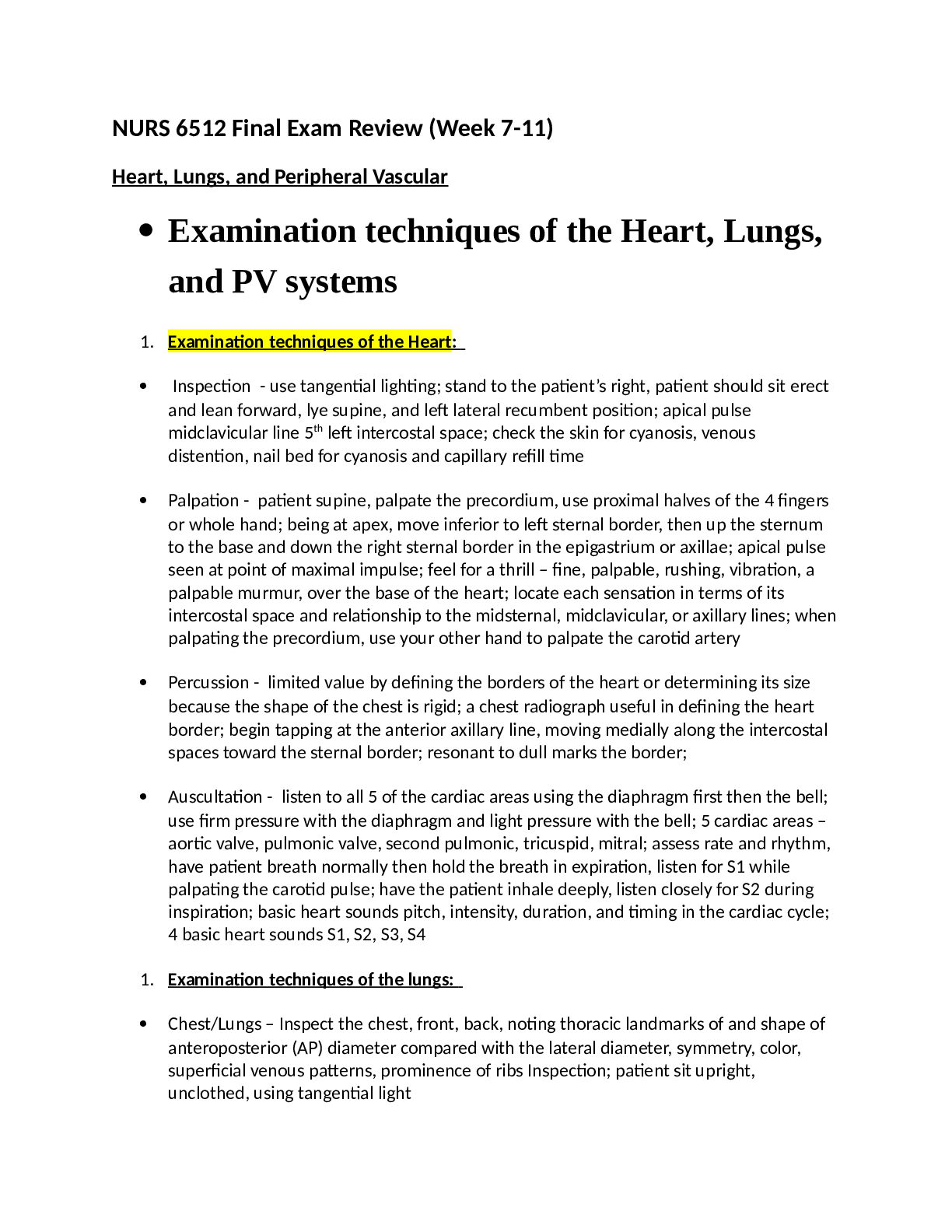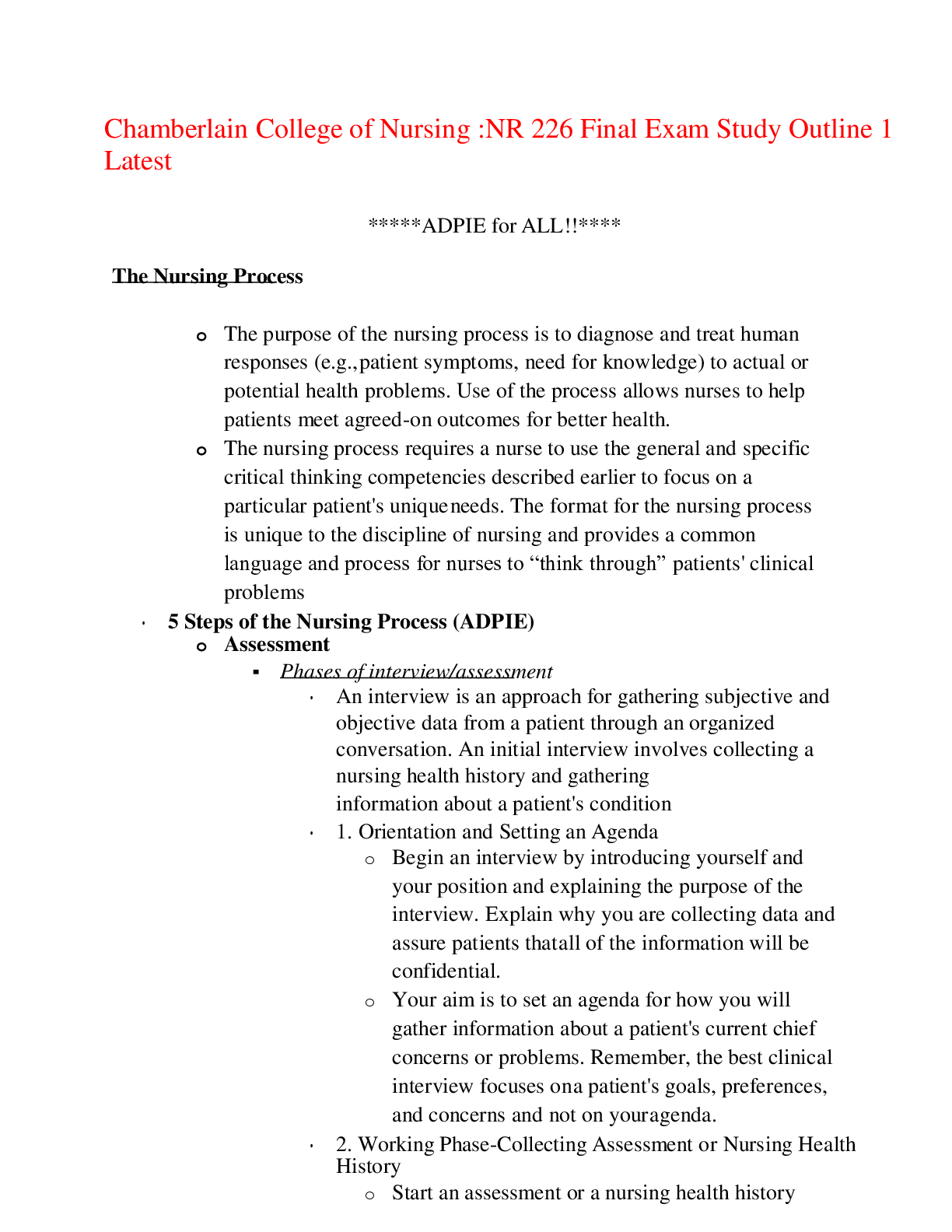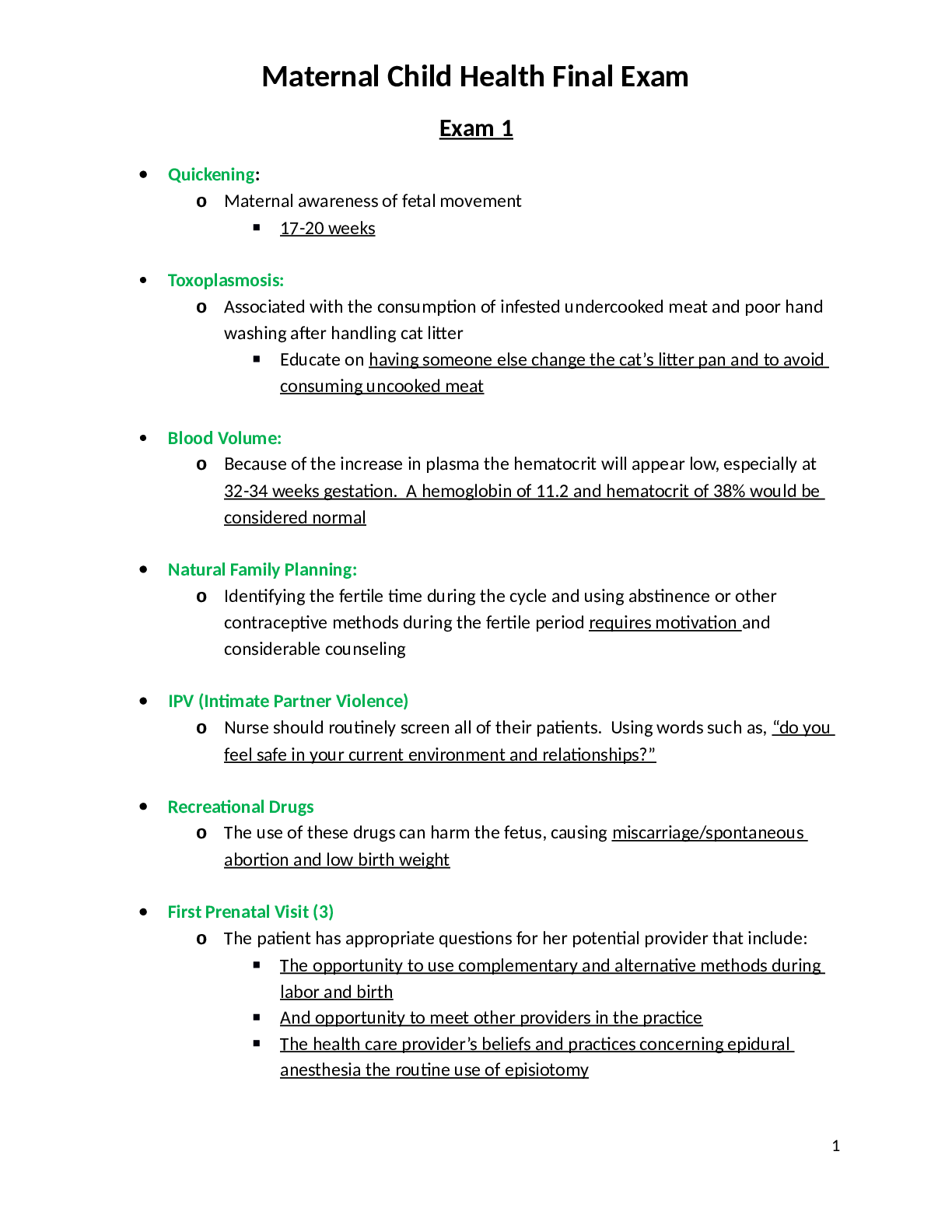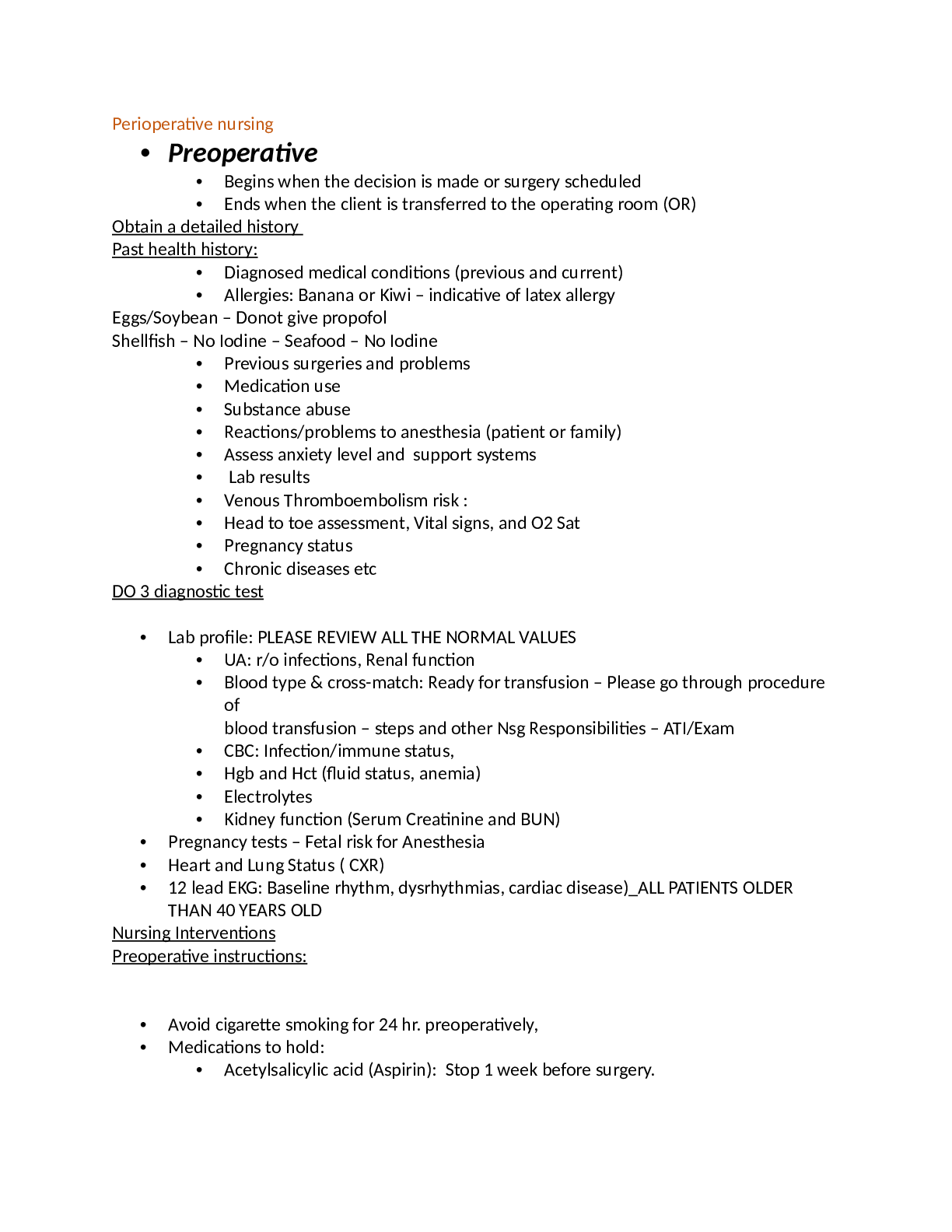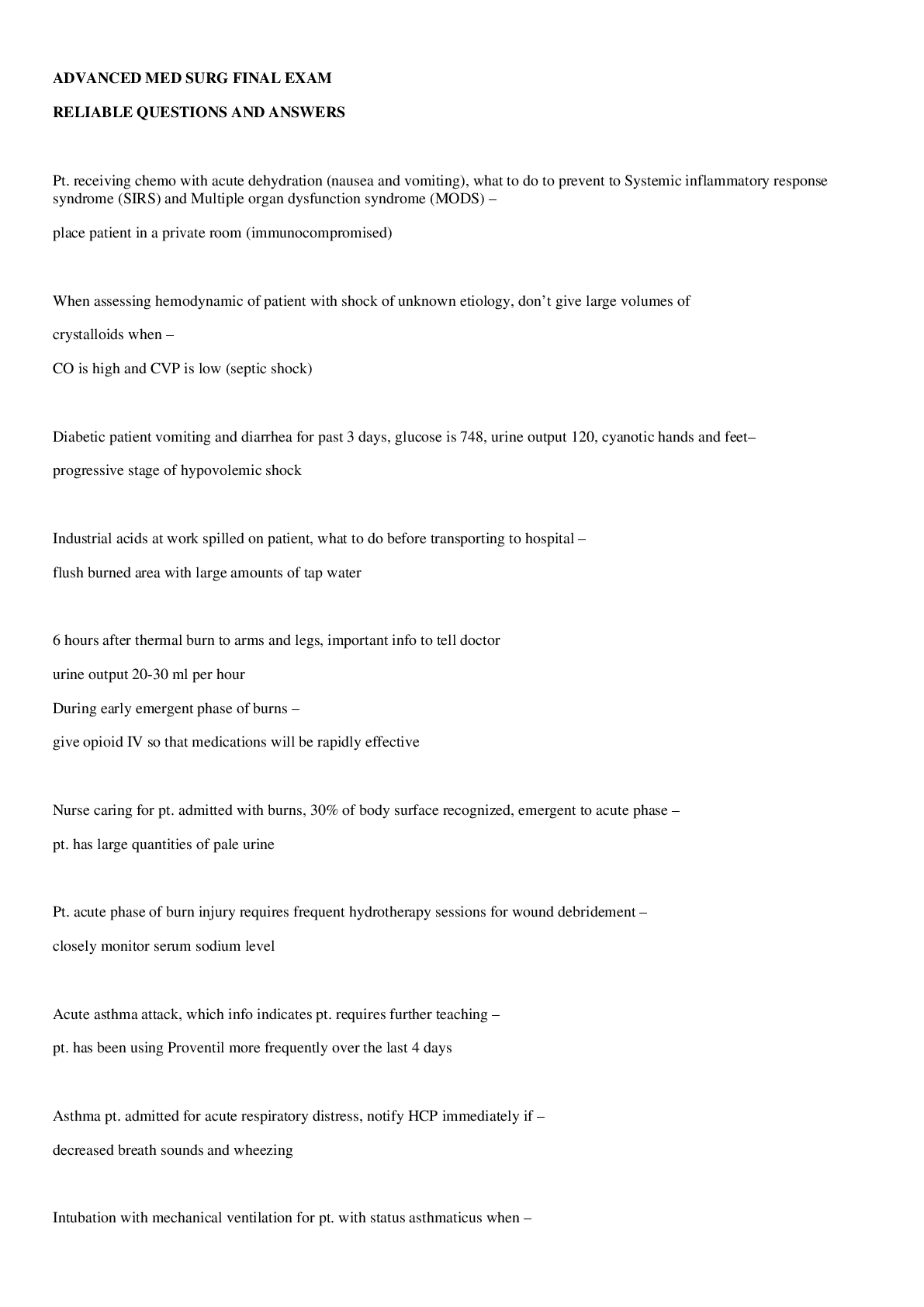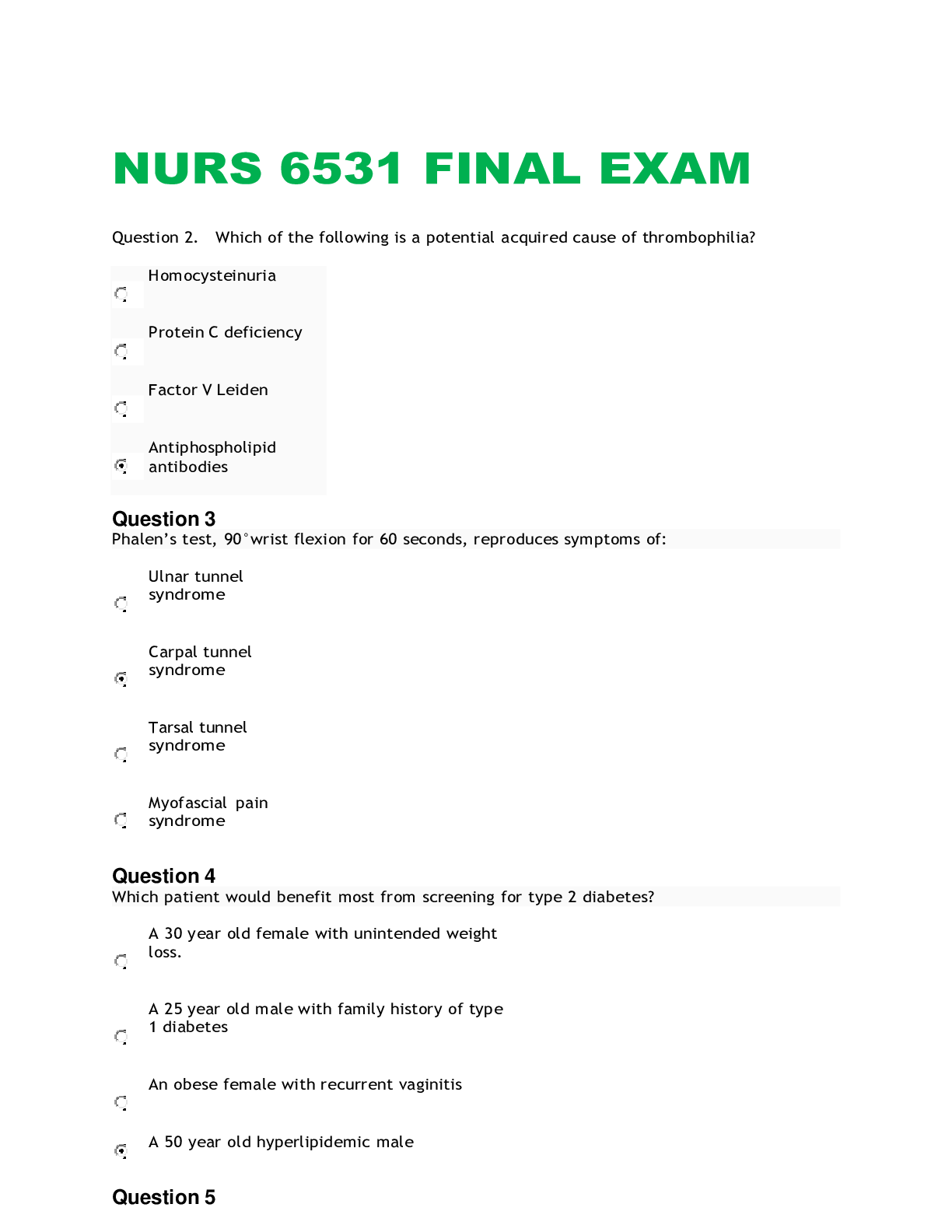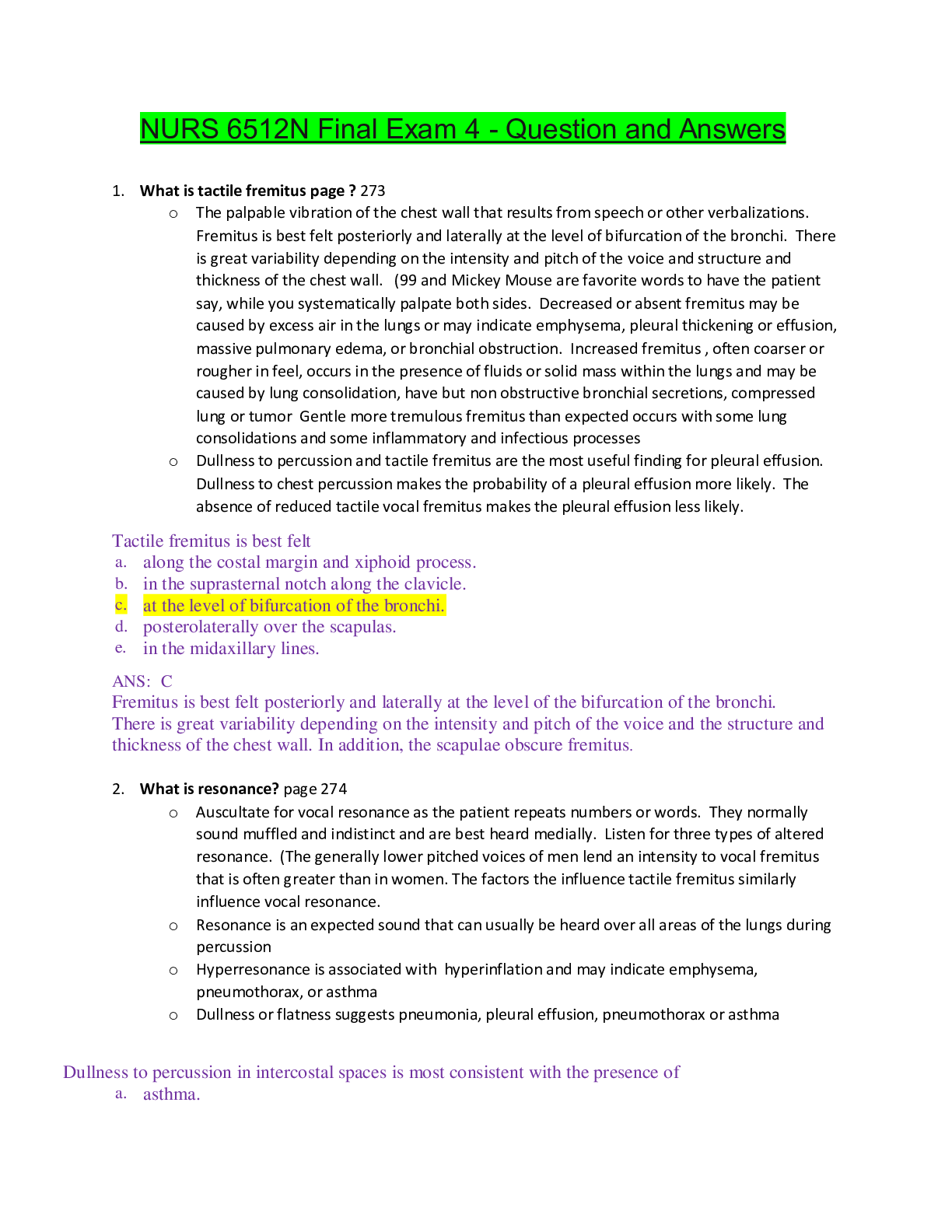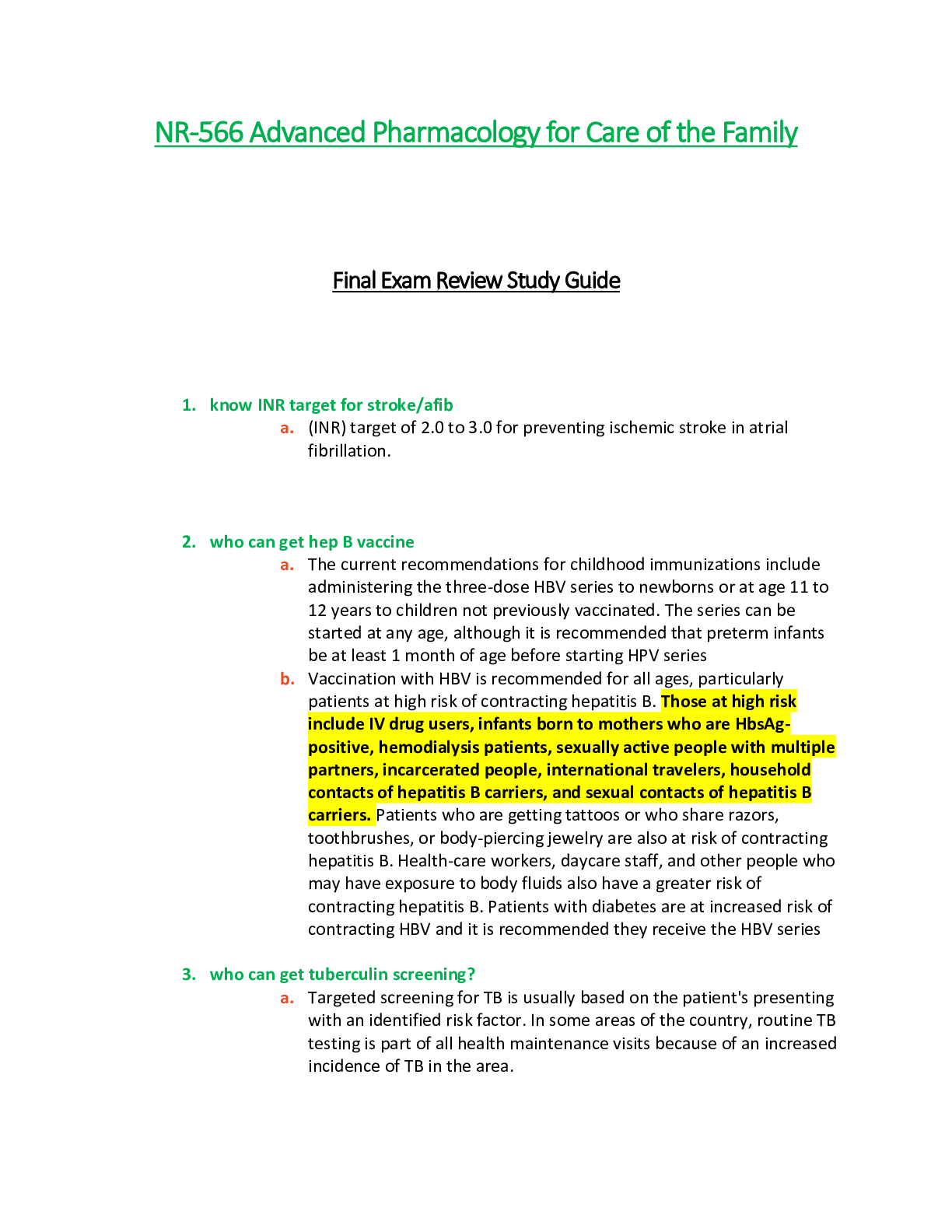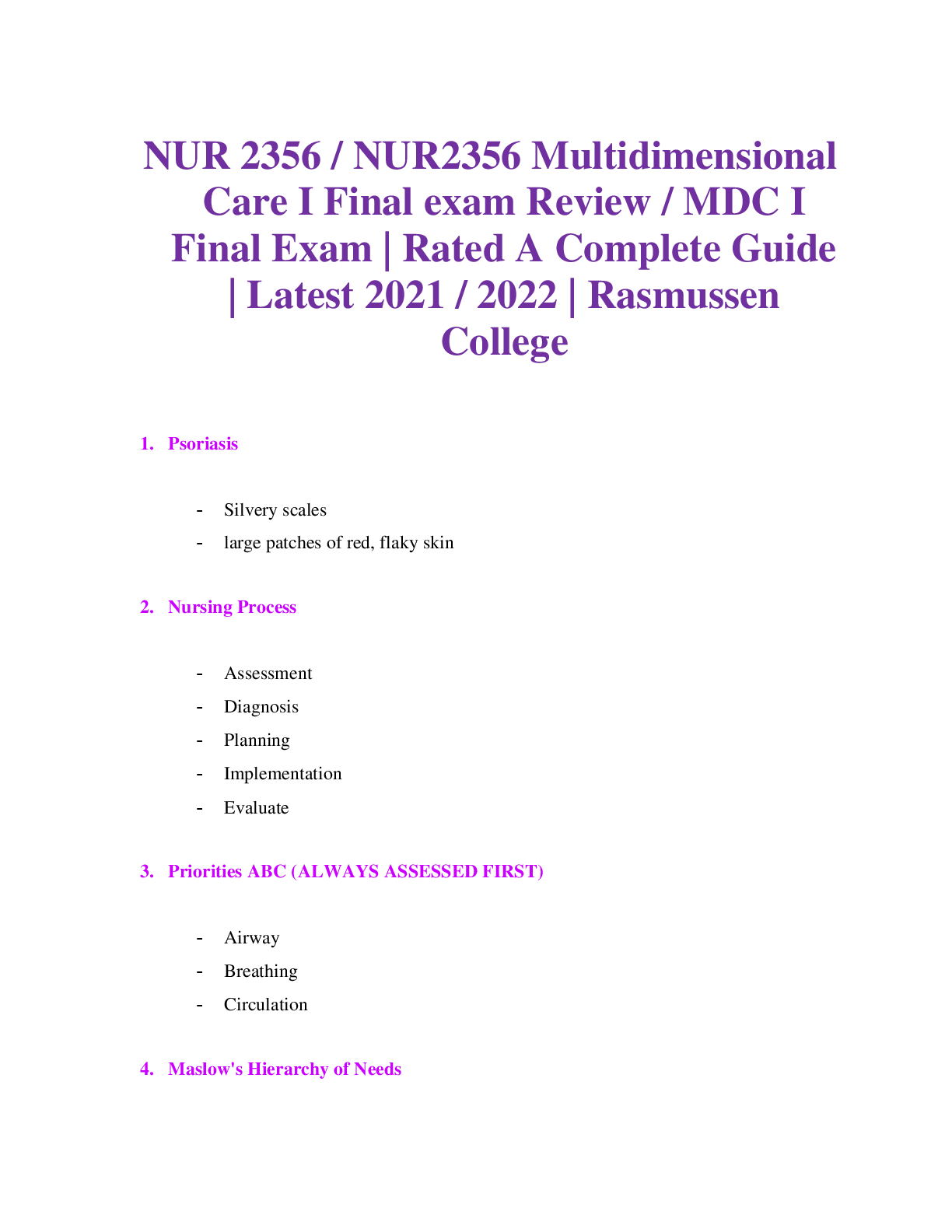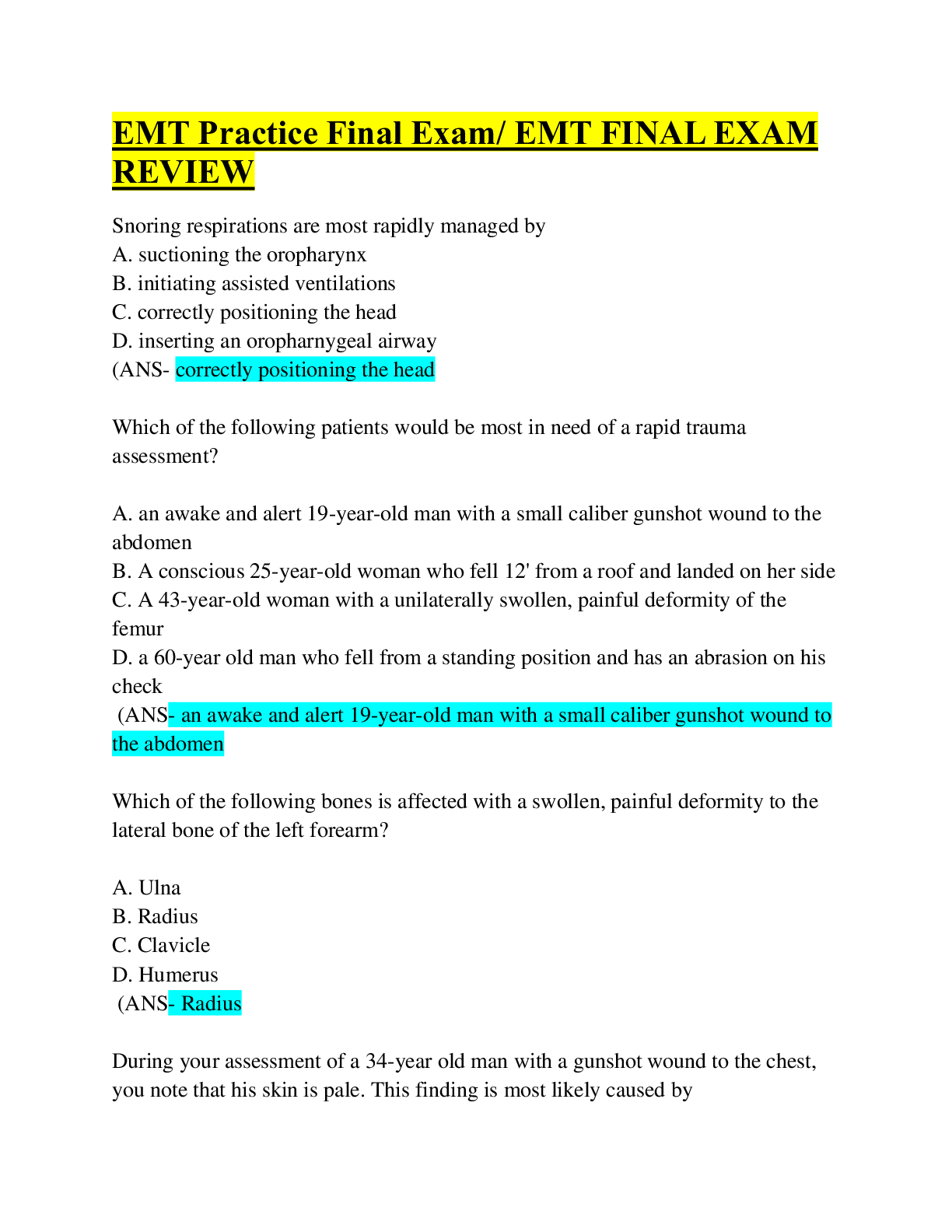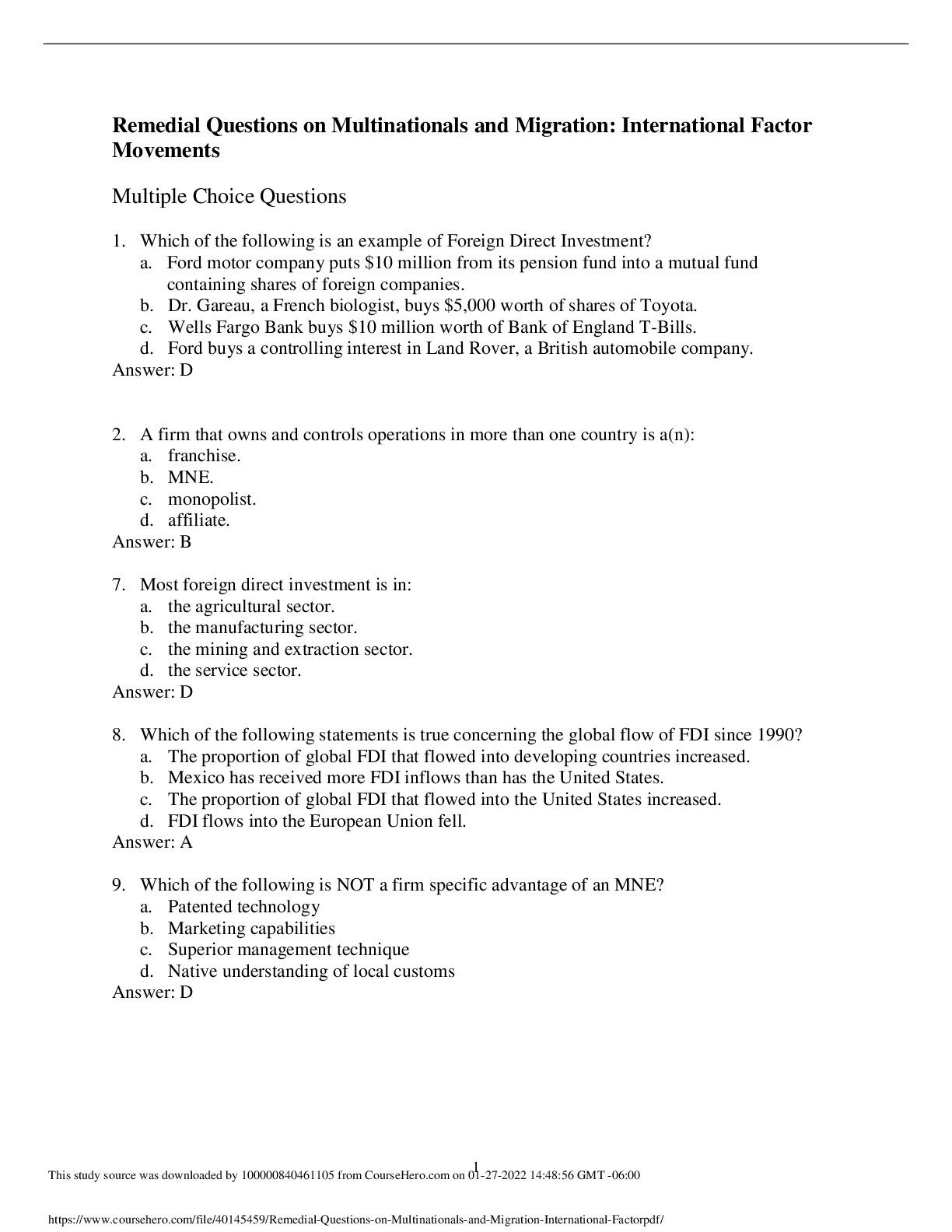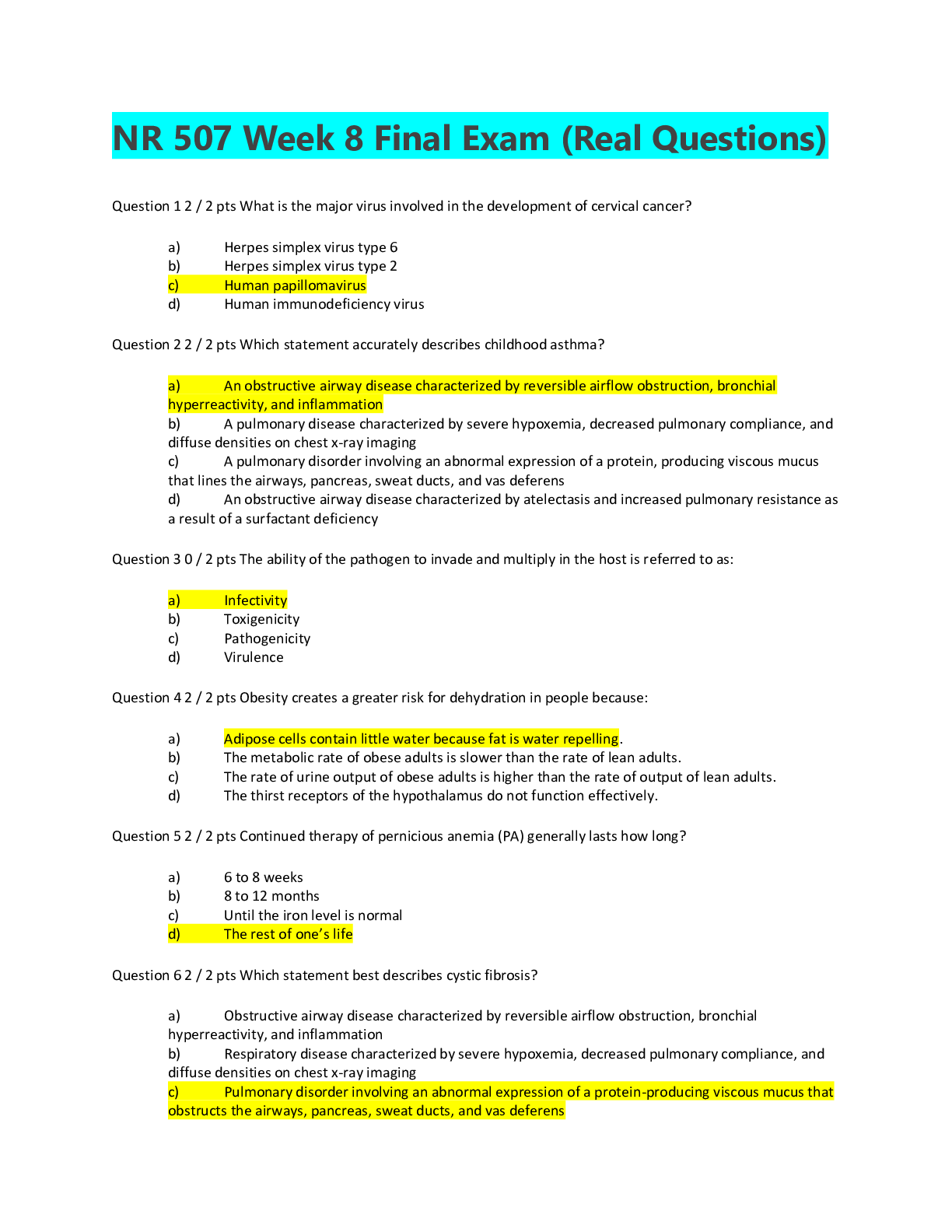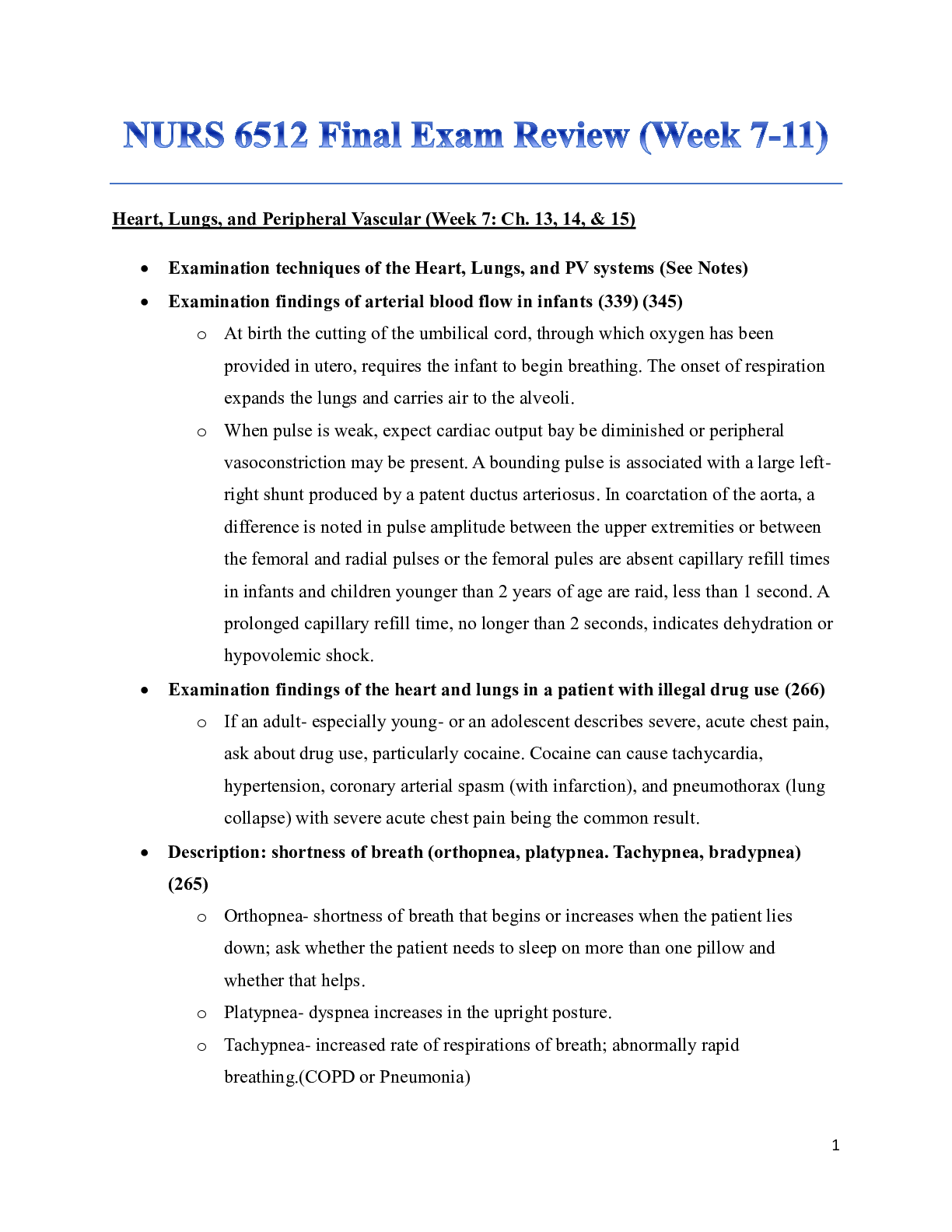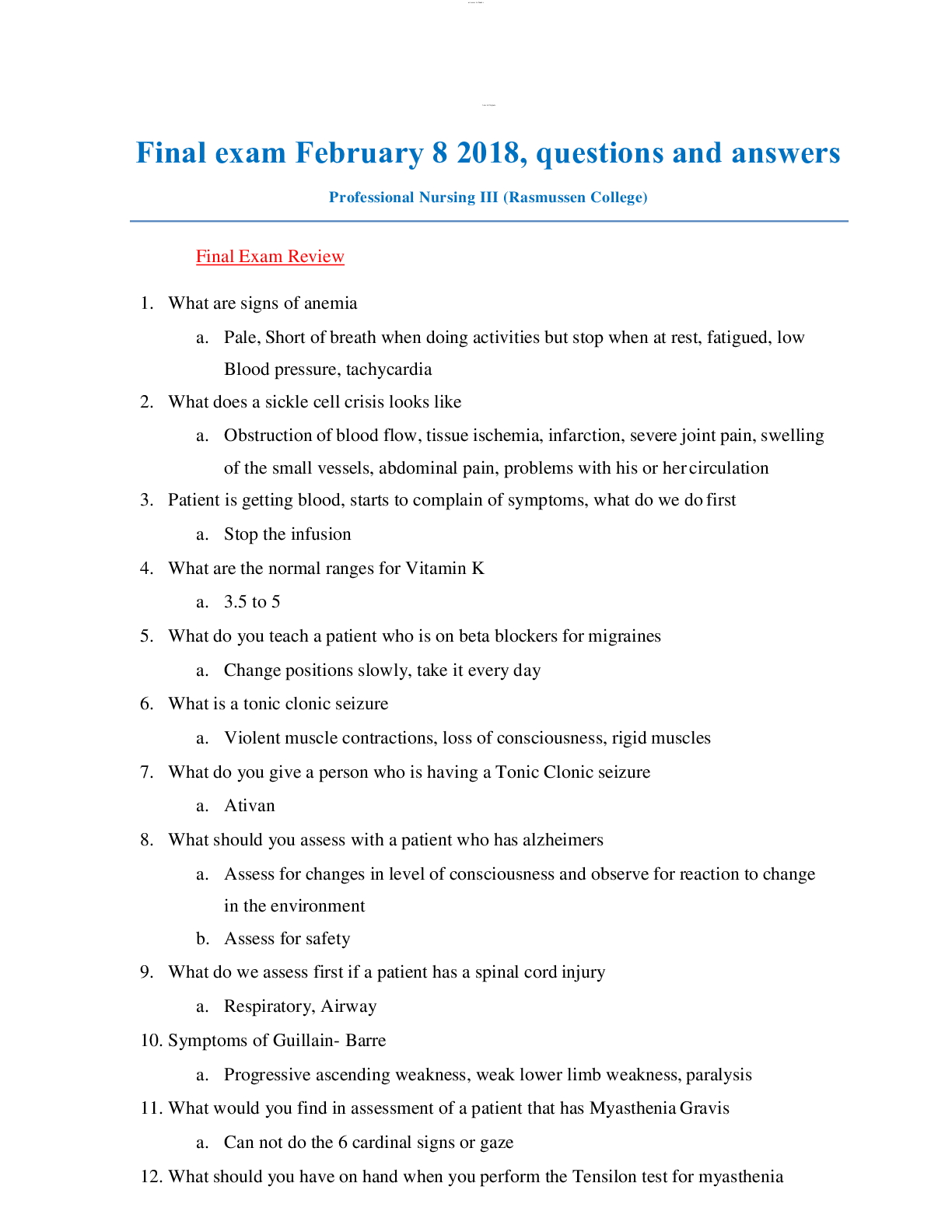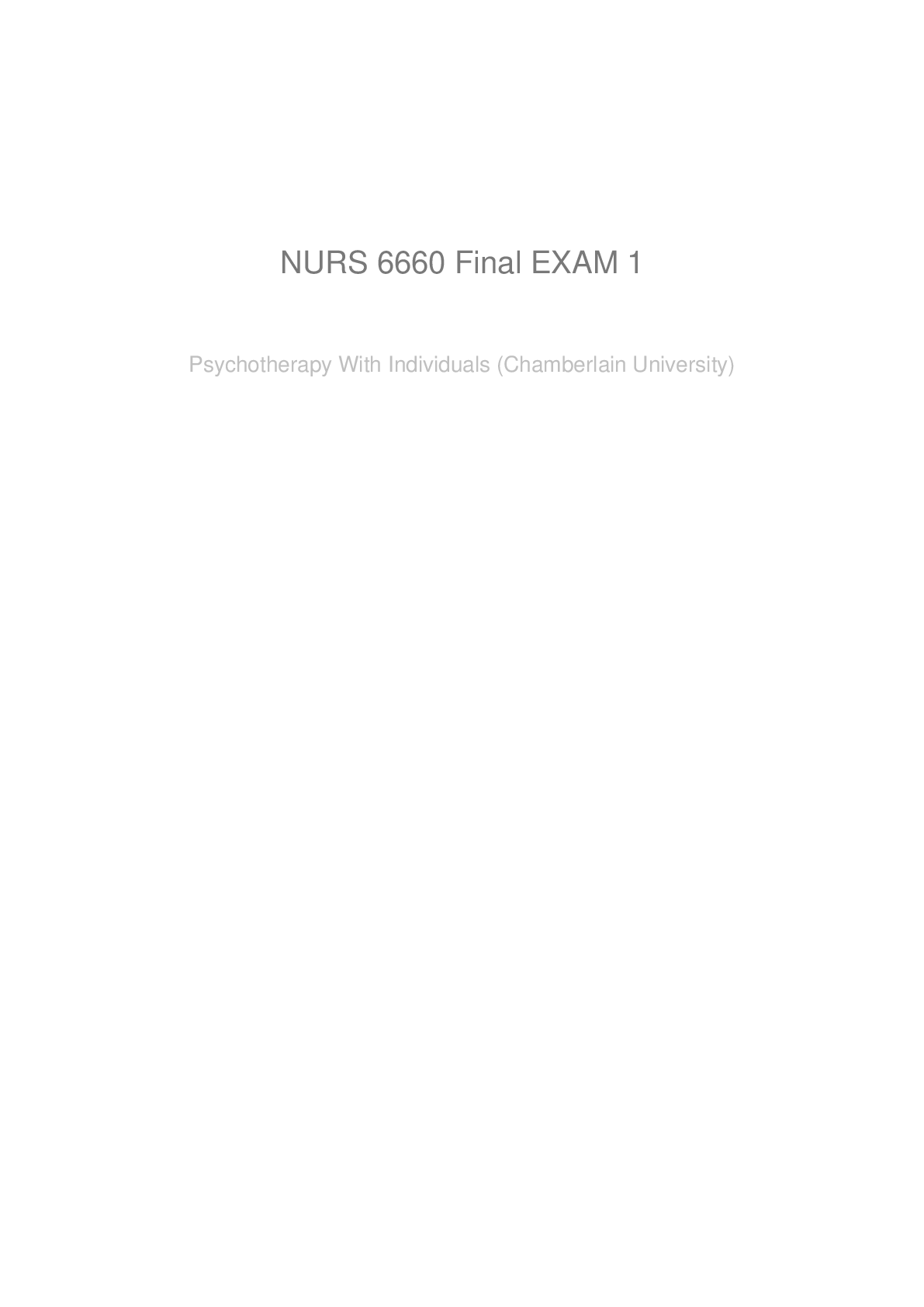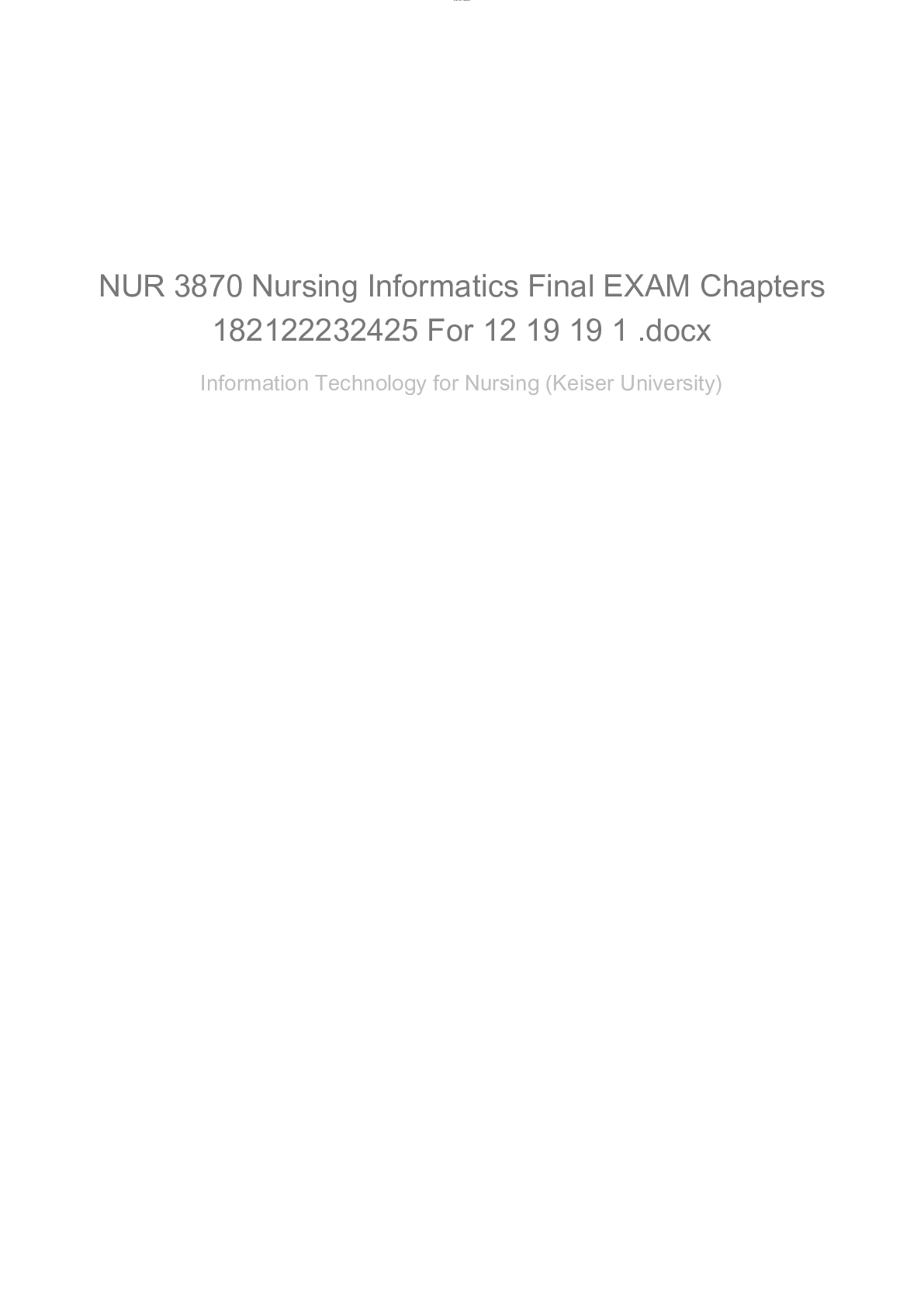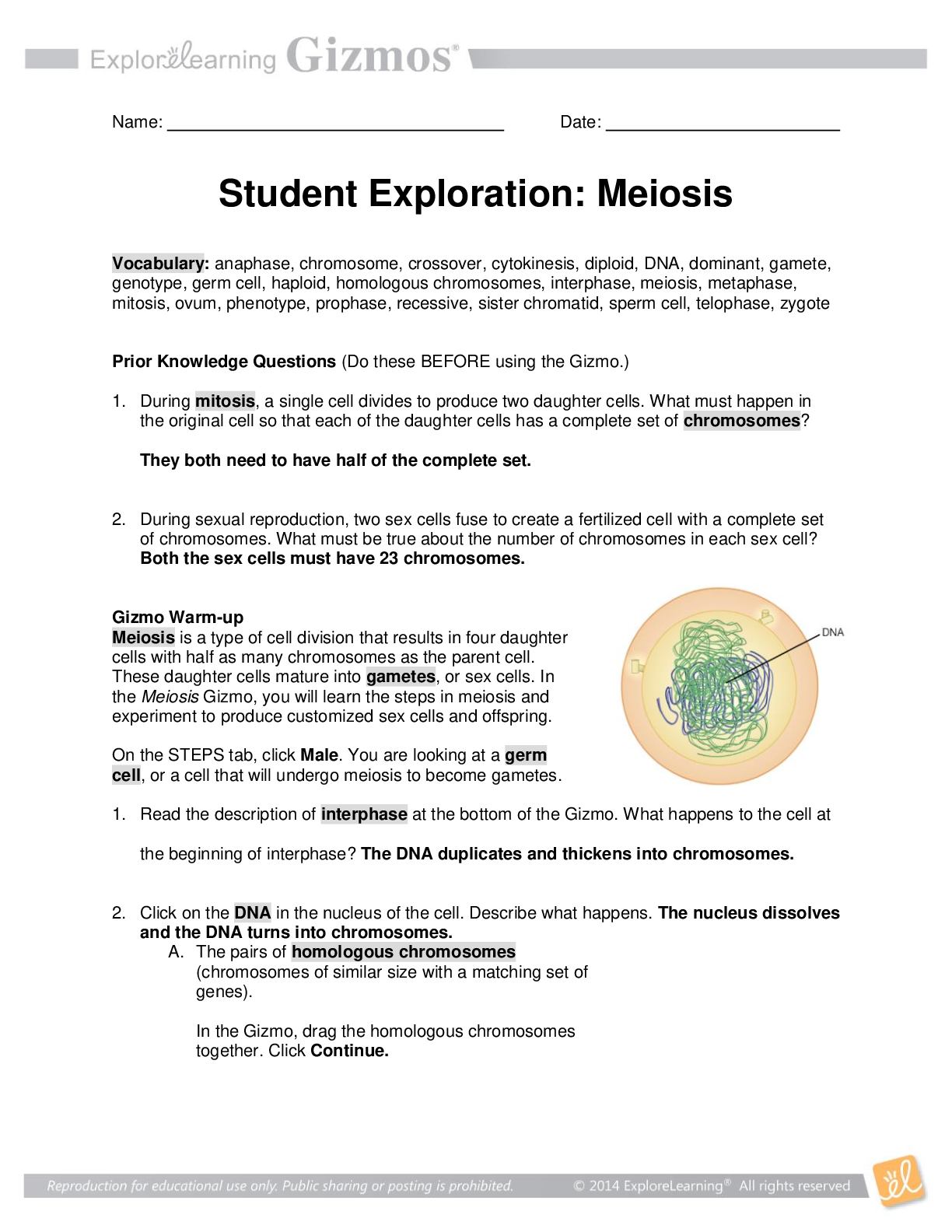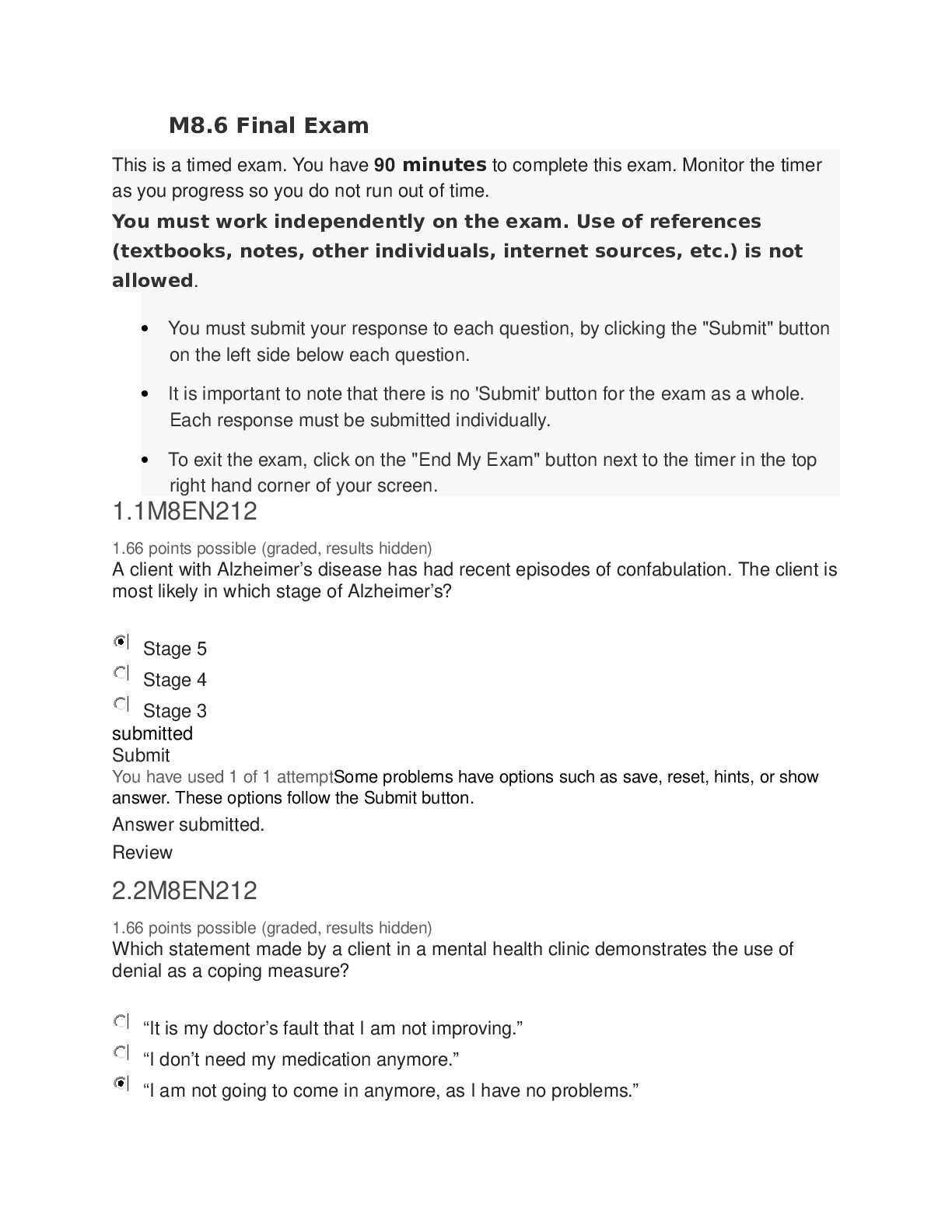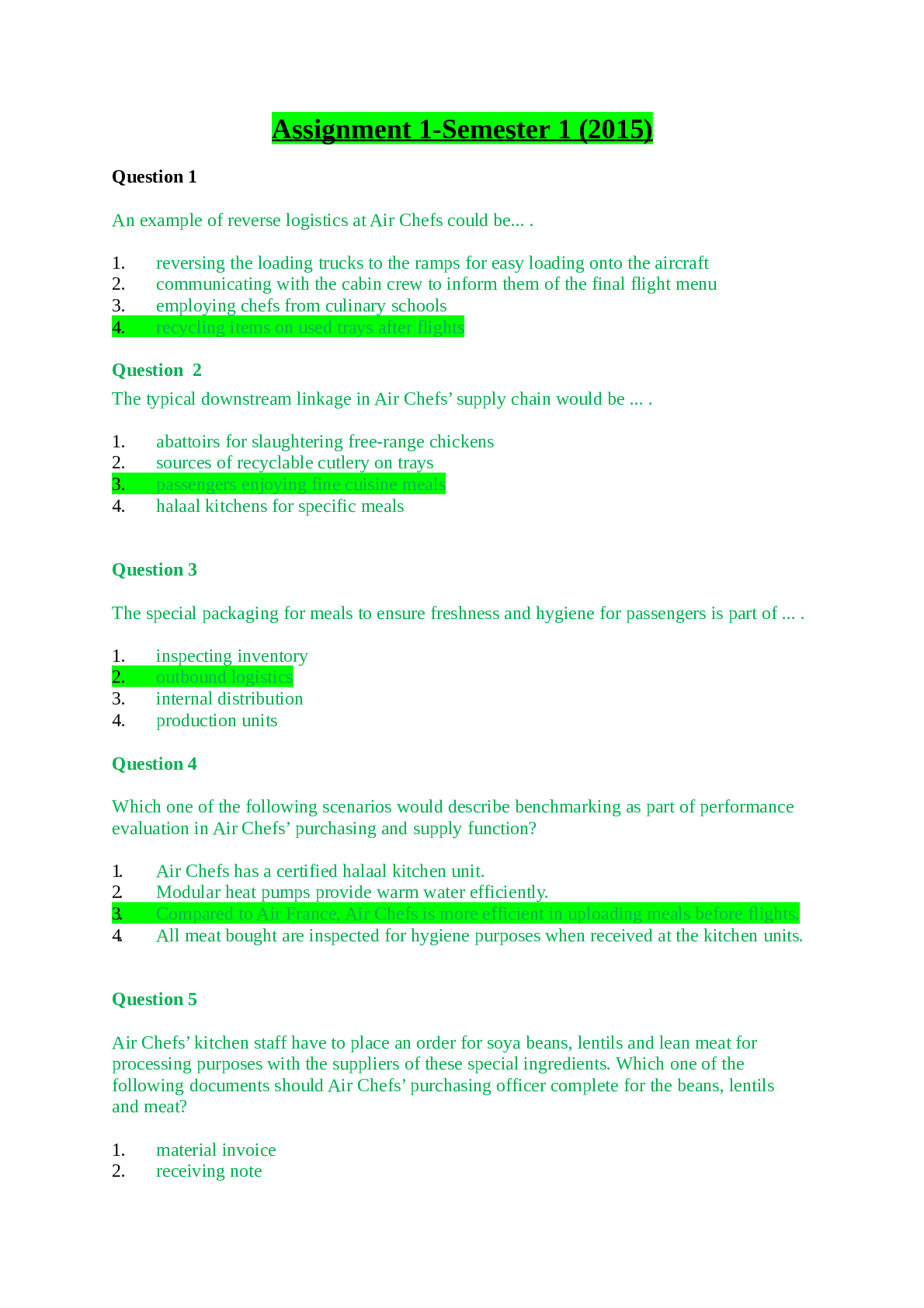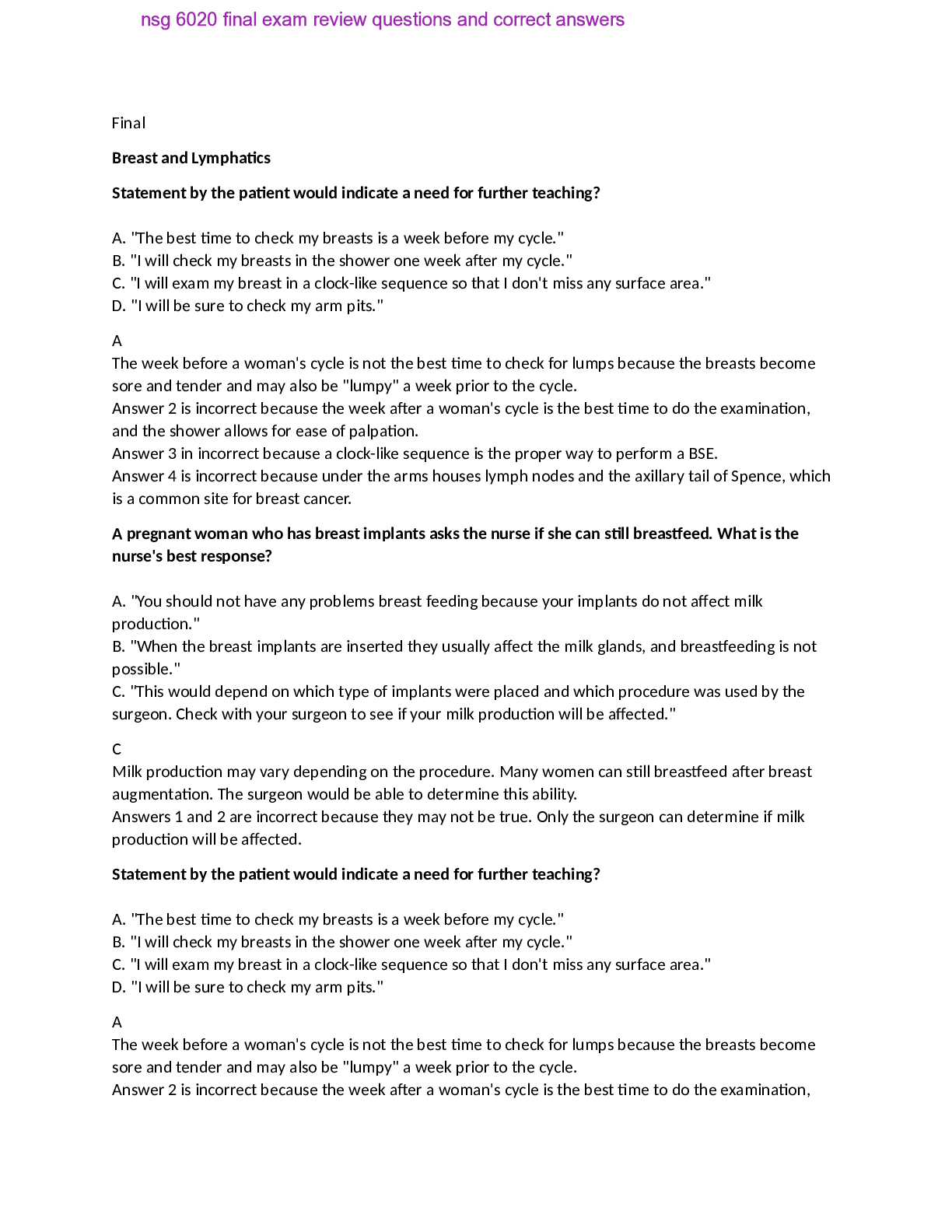Medical Studies > Final Exam Review > Final Points of Review for NR 120 Final Exam 100% Complete (All)
Final Points of Review for NR 120 Final Exam 100% Complete
Document Content and Description Below
a. Assessment before surgery - Verify that informed consent is completed, signed, and witnessed o The nurse witnesses the informed consent and make sure patient is clear about the procedure o The ... provider responds for description of the risks of anesthesia, benefits of procedure, potential harm, pain, discomfort - Ensure the preoperative checklist is completed - Assess psychosocial o Anxiety o Common fears - fear of death, pain, discomfort, alteration of body image, disruption of life functioning (daily activities, financial concern, family) Therapeutic communications Consult with social worker, spiritual or cultural advisor, financial advisor o Hope – negative/positive - Heath history o Past hospitalization o Previous surgeries and the dates – identify any problems with them o Female – last menstrual, number of pregnancies, history of C-section o Family heath history – history of cardiac (sudden cardiac death, MI), diabetes, hypertension, severe reaction with anesthesia - Medications o OTC drugs – aspirin, NSAIDs, o Herbal supplements astragalus, ginger increase BP vitamin E, garlic, ginko, fish oilincrease bleeding discontinue all herbal supplement 2 -3 weeks before surgery o Prescribed medications antihypertensive, antidepressant, anticoagulant can be held until after the procedure - Vital signs for baseline, assessment for pain - Assessment for allergies o Kiwi, banana latex allergies o Shellfish iodine - Assess cardiovascular o Blood pressure, pulses o Angina, HF, MI o Edema, JVD o Pacemaker, prosthetic heart valve - Respiration o COPD, asthma o Smoking o Breath sounds, rhythm - Neurologic assessment o A&O (x3) o Confusion b. Lab work to report Lab Normal range WBC 5,000 – 10,000/mm3 RBC Female: 4.7 – 6.1 million/uL Male: 4.2 – 5.4 million/uL Hgb Female: 12 – 16 g/dL Male: 14 – 18 g/dL Hct Female: 37 – 47% Male: 42 – 52% Platelets PTT, PT, INR 150,000 – 400,000 mm3 Electrolytes Na+ K+ 135 – 145 3.5 – 5.1 BUN Female: 0.6 – 1.1mg/dL Male: 0.7 – 1.3 mg/dL Creatinine Female: 88 – 128mL/min Male: 97 – 137mL/min Blood sugar 70 - 120 ABGs pH 7.35 – 7.45 PaCO2 35 – 45 HCO3 22 – 26 PaO2 80 – 100 SpO2 95 – 100% Electrolyte Na 135-145 K 3.5 5.0 Ca 8.5 – 10 Mg 1.5 – 2.5 Hgb A1C 4% - 6% accepted range for diabetes ppl 6.5% - 8% target goal: <7% c. Pre-op drugs ie: anticholinergics, anti-anxiety, PCA - antibiotics – cefazolin - anticholinergic – atropine, glycopyrrolate, scopolamine - antidiabetics – insulin - antiemetic – Zofran, Reglan - antianxiety – midazolam, diazepam, lorazepam - antihypertensive – labetalol - antihistamine – ranitidine - opioids – PCA morphine d. Teaching to patients pre-op - NPO for 8 – 12 hours before surgery - ensure denture, jewelry, nail polish, glasses are removed - the purpose and effects of preoperative medications that will be administered - post operative pain control techniques – medications, immobilization, PCA, splinting - chest therapy - splinting, coughing, deep breathing , incentive spirometer - ROM, early ambulation after the surgery, SCD, antiembolism stocking prevent DVT, pneumonia - Bowel and skin preparation - Postoperative diet – NPO, clear diet 2. Chapter 19 & 20- Post-Operative a. Nursing assessment & interventions to prevent complications/problems - frequent monitoring of vital signs o every 15 min for first hour o compare postop vital signs with preop/intraop VS ensure VS returning to the baseline - assess LOC o level consciousness, stimulation needed for arousal (pain, touch, verbal) o weakness, restlessness, orientation, agitation - assess for pain level o provide pain med 30 min before ambulation, dressing change - assess airway o gag reflex maintain NPO until return of gag reflex o swallow ability o artificial airway o O2 sat 95% o Respiratory pattern, rate, depth adequate oxygen o Lung sounds suctioning needed - Circulation o Hypovolemic shock – decreased BP, increased HR, RR o Skin color, temperature, sensation, cap refill, pulse, edema impaired circulation, DVT o Check mucous membrane, nail beds, lips for cyanosis o Monitor EKG o Fluid and electrolyte balance - Observe incision and drain sites o Report excess drainage the provider will do the first dressing changed o Asses Incision site fro manifestations of infection – redness, excessive tenderness, purulent drainage o Assess for dehiscence/ evisceration - Urination/bowel movement o Monitor and report urinary output < 30mL/hr o Abdominal distension o Bowel sounds on 4 quadrants o Maintain diet from clear to regular b. Teaching to patient post-op - instruct patient to cough, deep breath at least 1 hr while awake - instruct to splint with pillow or folded blanket for abdominal incision - assist with the use of incentive spirometer q1-2 hr while awake - reposition q2hr - ambulate early and regularly prevent DVT, pulmonary complications, cardiovascular disorders - do not put pillow under knees or elevate the knees gatch on the bed decrease venous return - encourage the client to ask for pain medication before pain gets severe - high in calories, protein, and vitamin C diet - maintain appropriate blood glucose with diabetic client 3. Ch 12, 23, 24; Wound care a. What impacts healing - nutrition deficiencies o protein – albumin level < 3 - poor circulation - infection - smoking impedes blood flow to healing area - mechanical friction of wound - aging slower in older adults - obesity decreased blood supply in fat tissues - diabetes - anemia b. Stages of pressure ulcers, what makes wound healing worse Stage I – intact skin, nonblancable redness, usually over a bony prominence; discoloration of skin, warmth, edema, hardness, or pain [Show More]
Last updated: 1 year ago
Preview 1 out of 25 pages
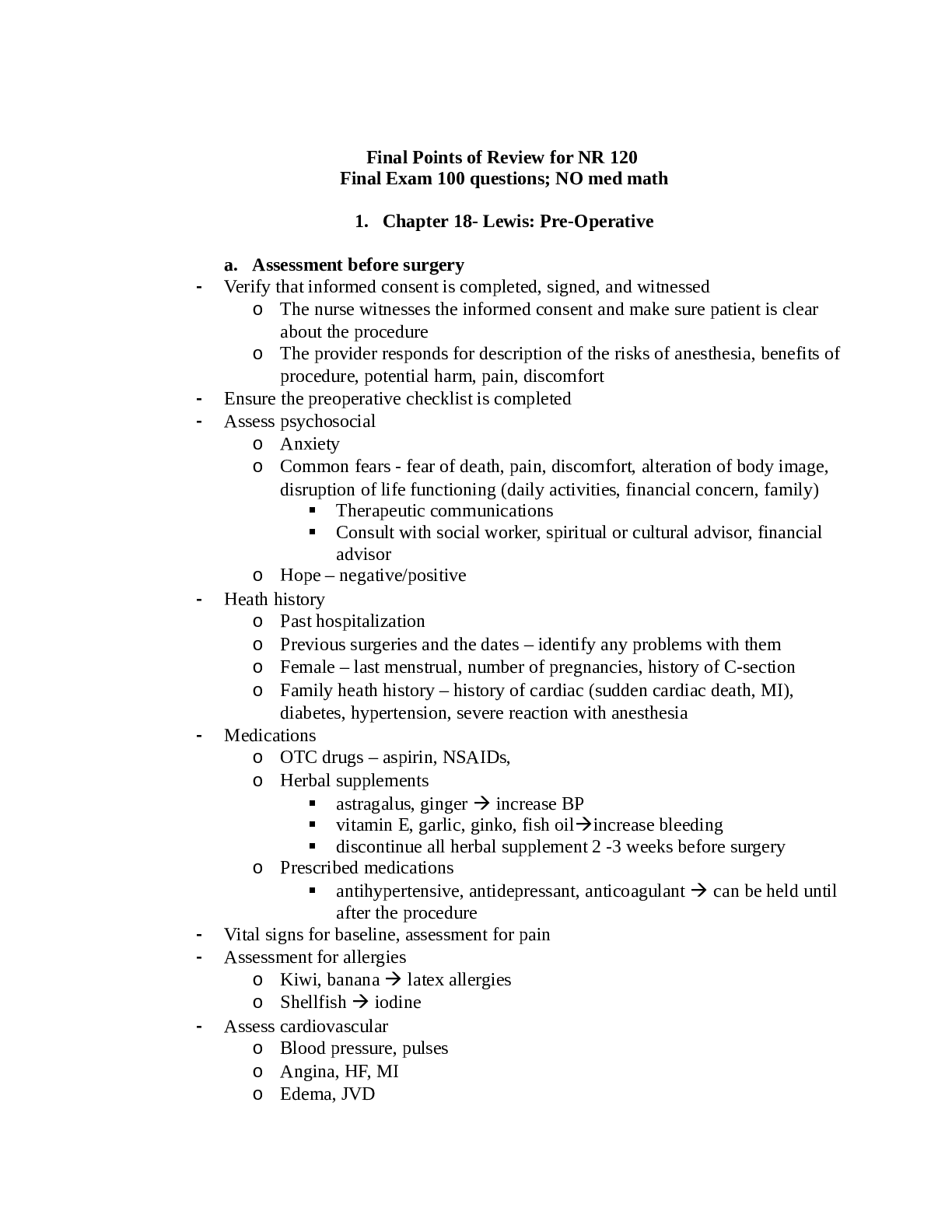
Reviews( 0 )
Document information
Connected school, study & course
About the document
Uploaded On
Jul 03, 2021
Number of pages
25
Written in
Additional information
This document has been written for:
Uploaded
Jul 03, 2021
Downloads
0
Views
86


